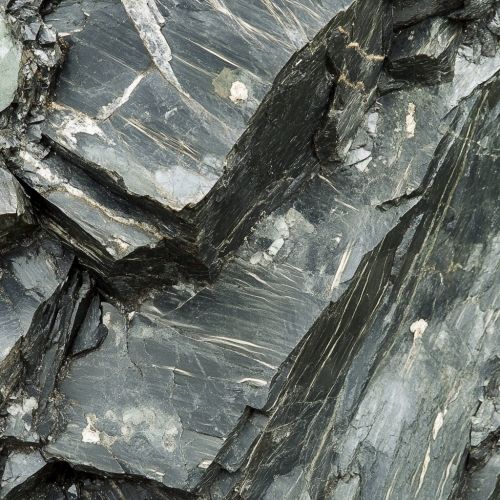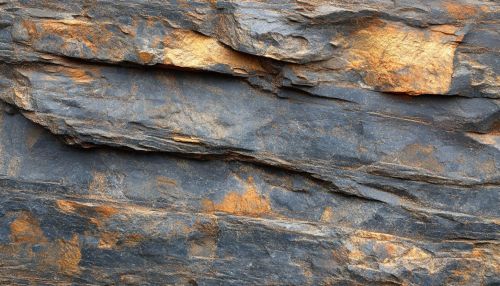Manhattan Schist: Difference between revisions
(Created page with "== Introduction == Manhattan Schist is a prominent geological formation found in the New York City area, particularly within the borough of Manhattan. This metamorphic rock is a significant component of the Manhattan Prong, a part of the larger Appalachian Mountain range. The schist is known for its durability and has played a crucial role in the city's architectural history, providing a stable foundation for many of its iconic skyscrapers. == Geological Composition ==...") |
No edit summary |
||
| Line 5: | Line 5: | ||
Manhattan Schist is primarily composed of minerals such as quartz, feldspar, and mica. The presence of these minerals gives the rock its characteristic foliated texture, which is a result of the intense heat and pressure it underwent during its formation. The schist also contains garnet, biotite, and occasionally staurolite, which contribute to its varied mineralogical composition. | Manhattan Schist is primarily composed of minerals such as quartz, feldspar, and mica. The presence of these minerals gives the rock its characteristic foliated texture, which is a result of the intense heat and pressure it underwent during its formation. The schist also contains garnet, biotite, and occasionally staurolite, which contribute to its varied mineralogical composition. | ||
[[Image:Detail-98179.jpg|thumb|center|Close-up of Manhattan Schist showing its foliated texture and mineral composition.|class=only_on_mobile]] | |||
[[Image:Detail-98180.jpg|thumb|center|Close-up of Manhattan Schist showing its foliated texture and mineral composition.|class=only_on_desktop]] | |||
== Formation and Metamorphism == | == Formation and Metamorphism == | ||
Latest revision as of 17:57, 8 October 2024
Introduction
Manhattan Schist is a prominent geological formation found in the New York City area, particularly within the borough of Manhattan. This metamorphic rock is a significant component of the Manhattan Prong, a part of the larger Appalachian Mountain range. The schist is known for its durability and has played a crucial role in the city's architectural history, providing a stable foundation for many of its iconic skyscrapers.
Geological Composition
Manhattan Schist is primarily composed of minerals such as quartz, feldspar, and mica. The presence of these minerals gives the rock its characteristic foliated texture, which is a result of the intense heat and pressure it underwent during its formation. The schist also contains garnet, biotite, and occasionally staurolite, which contribute to its varied mineralogical composition.


Formation and Metamorphism
The formation of Manhattan Schist dates back to the Paleozoic Era, approximately 450 million years ago, during the Taconic Orogeny. This period was marked by significant tectonic activity, which led to the collision of the North American Plate with a volcanic island arc. The immense pressure and heat generated by this collision caused the sedimentary rocks in the region to undergo metamorphism, transforming them into the schist we see today.
Structural Features
Manhattan Schist exhibits several notable structural features, including foliation, lineation, and folding. Foliation refers to the parallel alignment of mineral grains, which gives the rock its layered appearance. Lineation is the alignment of elongated minerals, which can indicate the direction of tectonic forces. Folding occurs when the rock layers are bent or curved due to compressional forces, resulting in complex structures that can be observed in outcrops throughout Manhattan.
Distribution and Exposure
Manhattan Schist is predominantly found in the northern and central parts of Manhattan Island. It is exposed at various locations, including Central Park, Morningside Heights, and Inwood Hill Park. These exposures provide valuable insights into the geological history of the region and serve as natural laboratories for studying metamorphic processes.
Engineering and Construction
The durability and strength of Manhattan Schist make it an ideal foundation material for construction. Its ability to withstand significant loads has been instrumental in the development of Manhattan's skyline. The rock's stability has allowed for the construction of some of the world's tallest buildings, including the Empire State Building and the Chrysler Building. Engineers and geologists often conduct detailed studies of the schist to ensure the safety and stability of new construction projects.
Environmental and Ecological Impact
The presence of Manhattan Schist has also influenced the local environment and ecology. The rock's rugged terrain and varied topography have created unique habitats for various plant and animal species. In Central Park, for example, the schist outcrops provide a natural setting for diverse flora and fauna, contributing to the park's ecological richness.
Historical Significance
Manhattan Schist has played a vital role in the history and development of New York City. Early settlers utilized the rock for building materials, and its presence has shaped the city's urban landscape. The schist's importance extends beyond construction, as it has also been a subject of scientific study for geologists seeking to understand the region's geological history.
